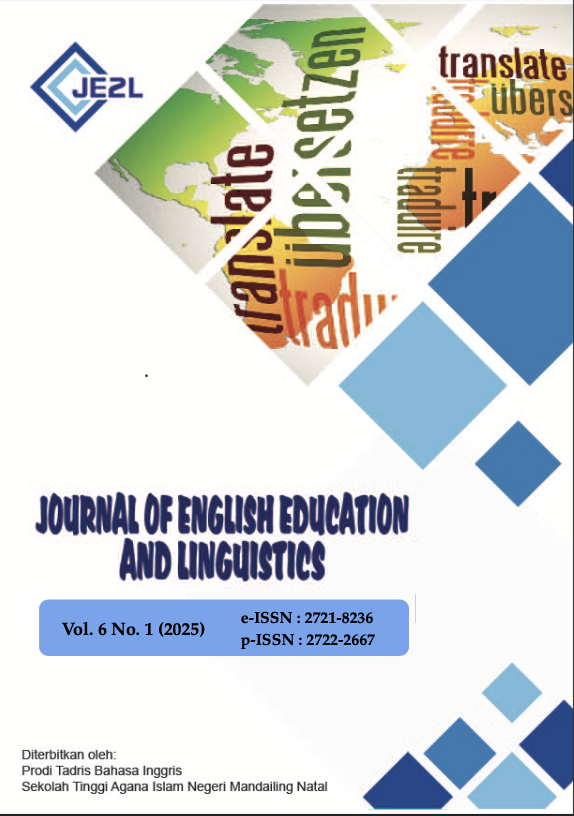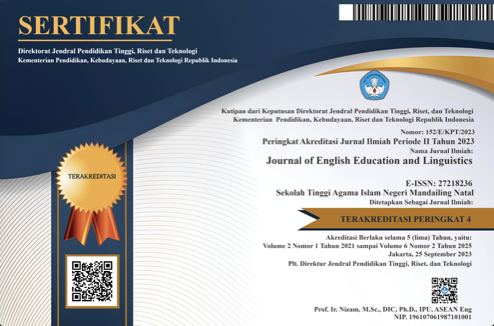HARNESSING GAME-BASED TOOLS IN EFL CLASSROOMS: MGMP TEACHERS’ PERSPECTIVES ON USING KAHOOT
DOI:
https://doi.org/10.56874/jeel.v6i1.2277Keywords:
Kahoot, collaborative teaching, digital tools, EFL classroom, game-based learningAbstract
This study explores how English teachers in an Indonesian MGMP (Musyawarah Guru Mata Pelajaran) community perceive and integrate Kahoot in EFL classrooms. Using a descriptive qualitative design, data were collected from six teachers through interviews, classroom observations, and document analysis. The results show that teachers use Kahoot for various pedagogical purposes, including vocabulary review, grammar reinforcement, and formative assessment. Teachers also employed different integration strategies, using Kahoot as warm-ups, comprehension checks, and review activities. Despite challenges such as limited internet access, lack of devices, and time constraints, teachers observed significant improvements in student motivation, participation, and confidence. The study highlights the role of professional collaboration within MGMP in supporting technology use, and the importance of teacher agency in adapting digital tools to meet classroom needs. The findings suggest that teacher-mediated gamification through Kahoot can enhance both engagement and learning outcomes in EFL contexts, particularly when supported by reflective teaching practices and local collaboration.
References
Bicen, H., & Kocakoyun, S. (2018). Perceptions of students for gamification approach: Kahoot as a case study. International Journal of Emerging Technologies in Learning, 13(2).
Braun, V., & Clarke, V. (2006). Using thematic analysis in psychology. Qualitative Research in Psychology, 3(2), 77–101.
Budiarto, M. K., Rahman, A., & Efendi, A. (2024). Proposing information and communication Technology (ICT)-Based Learning transformation to create competitive human resources: A theoretical review. Multidisciplinary Reviews, 7(4), 2024076.
Creswell, J. W. (2015). Educational research: Planning, conducting, and evaluating quantitative and qualitative research. pearson.
Deterding, S., Dixon, D., Khaled, R., & Nacke, L. (2011). From game design elements to gamefulness: defining" gamification". Proceedings of the 15th International Academic MindTrek Conference: Envisioning Future Media Environments, 9–15.
Dichev, C., & Dicheva, D. (2017). Gamifying education: what is known, what is believed and what remains uncertain: a critical review. International Journal of Educational Technology in Higher Education, 14, 1–36.
Elaish, M. M., Shuib, L., Ghani, N. A., & Yadegaridehkordi, E. (2019). Mobile English language learning (MELL): A literature review. Educational Review, 71(2), 257–276.
Ertmer, P. A. (2005). Teacher pedagogical beliefs: The final frontier in our quest for technology integration? Educational Technology Research and Development, 53(4), 25–39.
Hung, H.-T. (2017). Clickers in the flipped classroom: Bring your own device (BYOD) to promote student learning. Interactive Learning Environments, 25(8), 983–995.
Hwang, G.-J., & Wu, P.-H. (2012). Advancements and trends in digital game-based learning research: A review of publications in selected journals from 2001 to 2010. British Journal of Educational Technology, 43(1).
Ismail, M. A.-A., & Mohammad, J. A.-M. (2017). Kahoot: A promising tool for formative assessment in medical education. Education in Medicine Journal, 9(2).
K?yançiçek, E., & Uzun, L. (2022). Gamification in English language classrooms: the case of Kahoot! Bilim E?itim Sanat ve Teknoloji Dergisi, 6(1), 1–13.
Kormos, E., & Wisdom, K. (2021). Rural schools and the digital divide: Technology in the learning experience. Theory & Practice in Rural Education, 11(1), 25–39.
Licorish, S. A., Owen, H. E., Daniel, B., & George, J. L. (2018). Students’ perception of Kahoot!’s influence on teaching and learning. Research and Practice in Technology Enhanced Learning, 13(1), 1–23.
Mishra, P., & Koehler, M. J. (2006). Technological pedagogical content knowledge: A framework for teacher knowledge. Teachers College Record, 108(6), 1017–1054.
Najri, P. (2020). MGMP dalam meningkatkan keprofesionalan guru mata pelajaran. Aktualita: Jurnal Penelitian Sosial Keagamaan, 10(1), 130–144.
Plass, J. L., Homer, B. D., & Kinzer, C. K. (2015). Foundations of game-based learning. Educational Psychologist, 50(4), 258–283.
Plump, C. M., & LaRosa, J. (2017). Using Kahoot! in the classroom to create engagement and active learning: A game-based technology solution for eLearning novices. Management Teaching Review, 2(2), 151–158.
Selwyn, N. (2021). Education and technology: Key issues and debates. Bloomsbury Publishing.
Tetep, T., & Arista, Y. (2022). Students’ Perception towards Kahoot Learning Media and Its Influence towards Students’ Motivation in Learning Social Studies and Civic Education amid Pandemic in SMKN 9 Garut. The Innovation of Social Studies Journal, 4(1), 99–108.
Tondeur, J., Van Braak, J., Ertmer, P. A., & Ottenbreit-Leftwich, A. (2017). Understanding the relationship between teachers’ pedagogical beliefs and technology use in education: A systematic review of qualitative evidence. Educational Technology Research and Development, 65, 555–575.
Wang, A. I. (2015). The wear out effect of a game-based student response system. Computers & Education, 82, 217–227.
Zarzycka-Piskorz, E. (2016). Kahoot it or not? Can games be motivating in learning grammar? Teaching English with Technology, 16(3), 17–36.
Downloads
Published
Issue
Section
License
All articles published in the Journal of English Education and Linguistics are licensed under a Creative Commons Attribution-ShareAlike 4.0 International (CC BY-SA) license. This means anyone is free to copy, transform, or redistribute articles for any lawful purpose in any medium, provided they give appropriate attribution to the original author(s) and Journal of English Education and Linguistics, link to the license, indicate if changes were made, and redistribute any derivative work under the same license.
Copyright on articles is retained by the respective author(s) without restrictions. A non-exclusive license is granted to the Journal of English Education and Linguistics to publish the article and identify itself as its original publisher, along with the commercial right to include the article in a hardcopy issue for sale to libraries and individuals.
Although the conditions of the Creative Commons Attribution-ShareAlike 4.0 International (CC BY-SA) license do not apply to authors (as the copyright holder of your article, you have no restrictions on your rights), by submitting to the Journal of English Education and Linguistics, authors recognize the rights of readers and must grant any third party the right to use their articles to the extent provided by the license.

This work is licensed under a Creative Commons Attribution-ShareAlike 4.0 International License.








